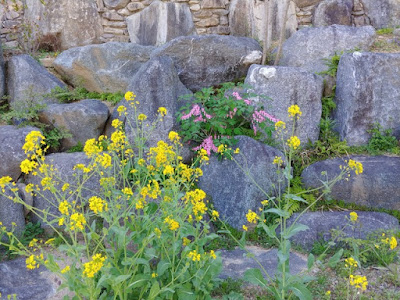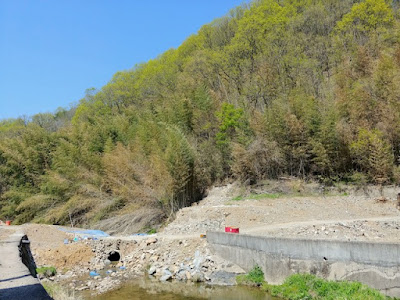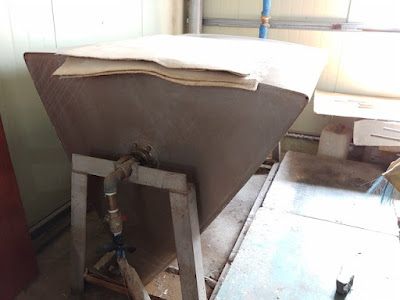In the usual Korean style, we didn't call Dr. Lee until we were almost to Jinju and checked to see if he was free for dinner. Thankfully he was, so I could give him a copy of Braiding Sweetgrass and say hi. This was at a really nice tea house we went to last time, run by an artist who also has a gallery attached in the back of the building, which is an old hanok that has been renovated.
I wanted something light so I got marigold tea. It seemed appropriate given that Dr. Jo is an expert hanji dyer.
We also revisited a place we had dinner during my last Jinju trip, for a wonderful seafood soup and seasonal banchan. The long green shoots next to the round dish of red sauce (gochujang) are a spring delicacy known as dureub. I can't tell if it's aralia or fatsia but the scent is a classical Korean one that indicates spring. I had some in Hwasun as well, so I've been really lucky.
Here it is, live, in front of another wonderful teahouse where Dr. Jo stopped so that I could visit another renovated hanok with beautiful views.
This teahouse is in Samga-myeon in Hapcheon-gun, such a treat.
The main goal of this trip was to visit a papermill that was the very first that I saw when I began my hanji research in Korea in 2008. On the way, Dr. Jo pointed out the views of the mountains that he loves to pass on the way home. We pulled over on the way up to take a look.
But not for long. This is classic Dr. Jo, always moving, always full of energy. He had brought delicious ttuk made of mugwort for a snack.
I was so happy to be able to see Shin Hyun-se back in action. This time, it was to watch him make giant sheets of hanji in the webal style (no frame on the screen, hung from a crossbar). He will never make this size hanji again as it's too hard.
I don't blame him. Regular sized hanji of this type is hard enough to pull and he is not a large man. He is my father's age (born in 1947) and still working every day at this incredibly difficult labor.
He stopped here to hose down the frame as it's time to add pulp, dak pul (the goo that helps with formation), and stir.
There's the last of the pulp as it sinks into the vat
And to my great relief, his apprentice does this labor (there is also a hog that they turn on when he agitates the vat, so that moves the fiber as well—the board on the corner of the vat keeps the slurry from splashing out as it's the location of the hog). Yes! He has an apprentice! I don't have the right spelling of his name but will share as soon as I have it. He's in his 30s and studied paper conservation with a professor who is very supportive of the hanji industry and convinced him to do this work. That anyone would willingly do this work after almost completing a master's degree is incredible. He spent two years at my teacher's mill and also several months in Japan, learning and absorbing along the way.I remember this bamboo. Sadly, the house that was in front is gone because the government is building a road right through this spot that will whiz right by the hanji studio (elevated). It will make it easier to get to this area but not sure how it will affect the air, water, trees, etc.
I remember this view as well. And you can't see them, but the roosters were still very noisy and boisterous.
I remember this gazebo, and was glad that this visit was not in the middle of summer!
Dr. Jo had this lovely wood sign made for the main mill entrance.
Some things remain the same, like the hydraulic press.
and the knife beater
This is where you rinse your bal (screen), which is much gentler than spraying it with a high-pressure hose like Americans like to do.This dryer moved a bit I think from last time, and turns so that you don't have to get on the other side of it, like
this one, but this one you can use for much larger sheets if you need.
The cooking area is now enclosed with a roof, so my photos are dark since I am not good enough with my manual settings and brought no tripod.
This is like gold, according to Dr. Jo, and I agree. Actually, better/more valuable than gold! Incredibly high-quality Korean dak fiber.
Dr. Jo provided tons of the old tools hanging on the wall.
I don't remember this stamper but it might have been covered up last time. Anyhow, it makes it easier to beat the fiber before it goes into the knife beater, easier than hand beating on rock slabs.
Not to be confused with the dochim machine, which is used to hammer dry paper that will be finished with this technique, in the main studio area.
Plenty of hwangchokgyu at left, from the roots of the "hibiscus" (technically Abelmoschus manihot) plant, and in its strained goo at right, to make dak pul.
You'd never know how heavy this screen with slurry is if you watch Mr. Shin work. He makes it look like it's light and easy to manipulate, which for any normal human it is decidedly not.
I seriously don't know how he does this without couching guides. He sets one corner down and then the rest of the screen.
I learned something very important here as well: to stop about 5cm before each side so as not to crush the ends of the post. I've been doing it wrong for years!
I love this system of grooves cut into the floor to channel water away to the drain. And Mr. Shin's tiny rubber shoes. So much simpler than huge rubber boots, but only good if you are super skilled and don't get water all over the place.
In the room where they pick bark bits from the cooked white bark, they moved things around a bit but I remember this clock that used to be in the drying room.
The apprentice was working alongside this ajumma but goes back and forth when he's called by Mr. Shin. She remains; this is mostly unacknowledged silent women's work.
Dried burdock to clean the screens
and seeds to plant more hwangchokgyu, because you have to yank up the roots every year for goo and keep it frozen to keep from spoiling. So you need more plants all the time.Threads unraveled for parting hanji
At the very left, one of several refrigeration unitsThe drying room has been cleaned up since last time, and the boards are now all on wheels to make it easier to move them without damaging sheets.
Mr. Shin's supporters helped put up these panels and photos of every step of the process.
Plus these images from when Mr. Shin was recognized in Italy for making paper good enough to treat and conserve Italian national treasures. This was when he and the people who govern his region finally understood how important hanji was, when a conservator came to him, weeping, to thank him for making such fine paper. The county agreed to fund an apprenticeship so that Mr. Shin could pass along this knowledge. He had refused to accept his current one many times but finally agreed after the county funded the apprenticeship three years ago.
Drying brush with the comb used to clean off hanji bits that gather in the bristles, with parting rods
Dried hanji!
This is the new addition: a box container to hold hanji inventory. Next to it is garlic that feeds the Shin family. The banner shows him making giant paper with his apprentice.Dr. Jo got a key to let me into the inventory space and then showed me more treasures.
This is taeji, freshwater algae hanji, that was part of Dr. Lee's big research project, to make it webal style. You can tell because on one side of the sheet, the tae (algae) is going in one direction: apmuljil makes it do that.
Then it goes in the perpendicular direction on the other side, because the yupmuljil makes it do that. As Dr. Jo said, the entire story of webal hanji is in this one sheet of paper. It explains the sheet formation method and looks very different from paper made with inclusions that would be pulled in a Japanese or western method.
This is the collection of naturally dyed papers that Dr. Jo dyed using Mr. Shin's hanji, which won a prize in the 44th Korea Annual Traditional Handicraft Art Exhibition.
The following year, another set of his dyed hanji was selected to be part of this show.
I get into every corner that I can but the pictures don't always turn out well.
Right before we left, Mr. Shin's wife came walking back from market, and gave us each a sweet red bean popsicle. It was a huge blast from the past, because when I was a child and visited Korea in the summer, my sister and I would get these on the walk back from art class to our grandparents' house in Seoul.
This is my favorite shot, two South Gyeongsang Province men chatting during a work break. If I am lucky, I'll be able to return again before I leave. For now, I am so grateful to have been able to make this trip because I never thought I would again. The best news I got on the way is that he was finally named, along with Lee Sang-ok, as an intangible cultural property holder of hanji making for his province. It took 3-4 years for the law to change to create the position, so I am relieved that both will be recognized while they are alive. That is mentioned in this great story about a huge dak tree that Dr. Jo found in Jinju that is the oldest and biggest likely in the whole country, which Dr. Lee managed to get moved to the forest science institute property, as well as Dr. Lee's big dak project. Watch even if you don't know Korean!




























































2 comments:
this seems almost too good to be true! such great news, aimee!
I'm currently studying conservation and preservation as part of my archival studies degree and we had your original 2008 video of Mr. Shin's workshop as one of our assigned videos for class. I was absolutely fascinated by the process, and, I have to admit, pretty worried about Mr. Shin for all the hard labour involved - I showed the video to a friend of mine and we agreed that 1) it's a truly incredible process (hibiscus root!) and 2) Mr. Shin really needed an apprentice. Imagine my delight when I looked him up and learned that he had an apprentice to help him out at last! And funded by the county government at that! What a delight, so glad you got to reunite with him too. Thanks for documenting all this hard work in such great detail - we're always having the importance of artifacts' production histories hammered into us in archival studies, but I feel like sometimes we can neglect the importance of the production of our tools, too.
Post a Comment